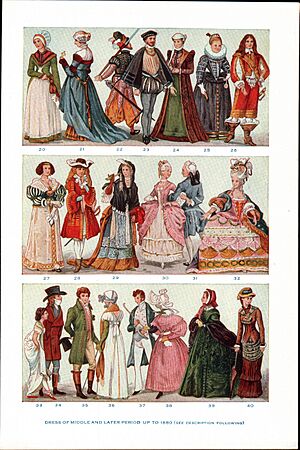History of Western fashion facts for kids
Have you ever wondered why clothes look so different in old movies or pictures? The history of Western fashion is all about how clothing styles have changed over hundreds of years. This journey covers countries influenced by the Western world, mainly those in Western Europe and English-speaking nations. It's a fascinating look at how people dressed, what was popular, and how clothes reflected their lives.
Contents
Exploring Western Fashion History
What is Western Fashion?
Western fashion refers to the clothing styles that have been popular in countries influenced by European culture. This includes places like Western Europe, the United States, Canada, Australia, and New Zealand. It's a big topic that covers everything from fancy dresses to everyday clothes.
Why Does Fashion Change?
Fashion doesn't just change on its own. Many things influence how clothes look over time.
- New Technologies: Inventions like the sewing machine or new ways to make fabrics can totally change what's possible.
- Social Changes: Big events like wars or new ideas about how people should live can affect clothing. For example, during wartime, clothes often became simpler and more practical.
- Cultural Trends: Art, music, and even famous people can inspire new styles. Think about how pop stars influence what people wear today!
- Economic Factors: When times are good, people might spend more on elaborate clothes. When money is tight, fashion might become more basic.
A Look Through Time
Fashion history is often divided into different periods, usually by centuries or even decades. Each period has its own unique look and feel.
Early Times (400s to 1400s)
In the early days, clothing was often simple and practical. People wore tunics, cloaks, and robes. Styles changed slowly, and clothes were mostly made from wool or linen. As time went on, clothes became more fitted and decorative, especially for richer people.
Renaissance and Beyond (1400s to 1700s)
During the Renaissance, fashion became much more elaborate. People started wearing rich fabrics like velvet and silk. Clothes often had many layers, puffed sleeves, and intricate embroidery. Later, in the 1600s and 1700s, styles became very grand, with wide skirts, corsets, and powdered wigs for both men and women.
Modern Eras (1800s to Today)
The 1800s saw big changes with the Industrial Revolution. Clothes became easier to make, and fashion changed more quickly. Women's dresses often had very full skirts, supported by petticoats or hoops. Men wore suits that looked more like what we see today.
In the 1900s, fashion sped up even more. The 1920s brought flapper dresses, while the 1950s had full skirts and tailored looks. The 1960s introduced mini-skirts and bold patterns. Each decade since has had its own distinct trends, from the big hair and shoulder pads of the 1980s to the casual styles of the 1990s and 2000s.
Today, fashion is incredibly diverse. People can choose from many different styles, and trends often mix old and new ideas.
Related Fashion Topics
Learning about fashion history also involves understanding other interesting areas.
- Buttons: Small but important parts of clothing that have their own history.
- Clothing history: The broader story of how humans have covered themselves.
- Fashion design: The art of creating new clothing styles.
- Haute couture: High-end, custom-made fashion.
- Sewing: The skill of making clothes with needle and thread.
- Tailor: A person who makes, repairs, or alters clothes, especially suits.
- Victorian fashion: The specific styles popular during Queen Victoria's reign (1837-1901).



